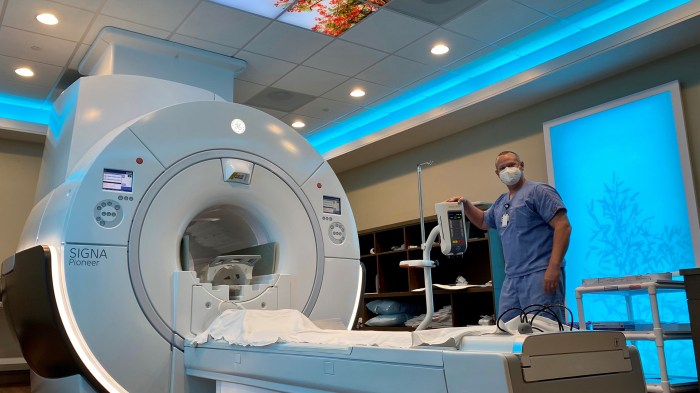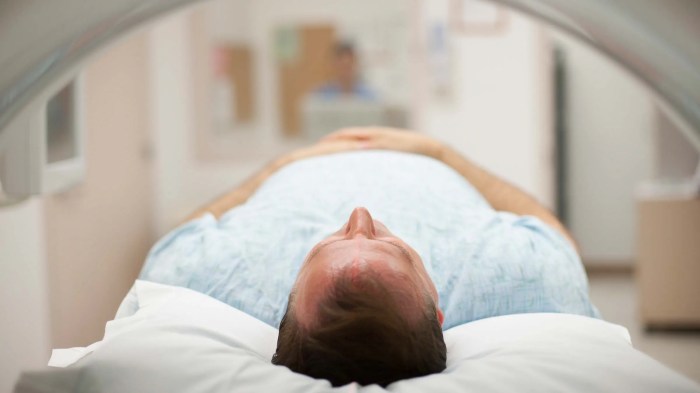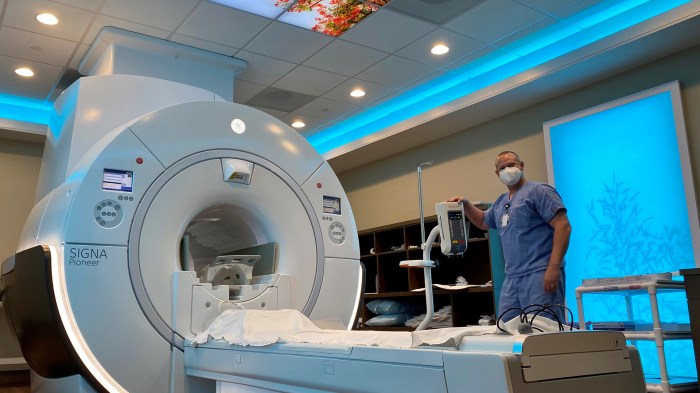What is a medical spa? It’s more than just a fancy spa; it’s a blend of advanced medical procedures and luxurious relaxation. This unique space offers a wide range of services, from aesthetic enhancements to non-invasive treatments, all overseen by licensed medical professionals. Delving deeper, we’ll explore the specifics, comparing them to traditional spas, examining the services, regulatory aspects, and the overall client experience.
Imagine a space where you can rejuvenate your body and mind while benefiting from expert medical care. This is the essence of a medical spa. From aesthetic injectables to laser treatments, and advanced skin care, a medical spa offers a holistic approach to beauty and well-being. We’ll unpack the nuances of these services, the expertise behind them, and the regulatory framework that ensures safety and quality.
Defining a Medical Spa
A medical spa is a unique blend of relaxation and rejuvenation with the expertise of licensed medical professionals. It’s more than just a traditional spa; it integrates medical treatments and procedures, offering personalized care and advanced technologies to enhance beauty and overall well-being. This approach often addresses concerns beyond aesthetic enhancements, providing holistic solutions for specific health and wellness goals.Medical spas are designed to offer tailored treatments, utilizing advanced medical technology and the expertise of licensed professionals to address diverse needs.
They aim to improve not only appearance but also underlying health conditions, providing a comprehensive and effective approach to wellness.
Key Characteristics of a Medical Spa
Medical spas differ significantly from traditional spas. The core distinction lies in the integration of medical treatments with relaxation and rejuvenation. Traditional spas primarily focus on relaxation, massage, and aesthetic treatments. Medical spas go a step further, incorporating medical procedures, technologies, and the oversight of licensed medical professionals. This combination of medical expertise with spa amenities creates a unique and often highly effective approach to wellness.
Medical Spa vs. Traditional Spa
| Feature | Medical Spa | Traditional Spa |
|---|---|---|
| Services Offered | Includes medical procedures like Botox, fillers, laser treatments, skin peels, and often, treatments for specific conditions like acne or rosacea. Also, often incorporates therapies to improve blood circulation and muscle function. | Focuses on relaxation techniques like massage, aromatherapy, body wraps, and beauty treatments such as manicures and pedicures. |
| Staff Qualifications | Requires licensed medical professionals like dermatologists, plastic surgeons, and registered nurses, alongside spa therapists. | Staff is typically trained in massage therapy, esthetics, and other spa-related disciplines. |
| Regulatory Oversight | Subjected to stricter regulations and licensing requirements, ensuring patient safety and the appropriate use of medical technologies. | Typically has less stringent regulatory oversight compared to medical spas. |
| Patient Care | Offers comprehensive consultations and personalized treatment plans, often addressing underlying health concerns. | Focuses on relaxation and well-being, but may not address specific health conditions. |
Medical Spa vs. Medical Clinic
A medical spa and a medical clinic both employ medical professionals, but their focuses differ significantly. A medical clinic primarily addresses acute and chronic medical conditions through diagnosis and treatment. Medical spas, on the other hand, focus on preventative care, wellness, and enhancement of the patient’s overall well-being. A medical spa may offer some treatments found in a medical clinic, but the approach is usually more holistic and integrated with spa services.
For example, a medical spa might offer a laser treatment for skin rejuvenation, whereas a medical clinic would use it to treat skin conditions. The goal of the medical spa is not just to treat a condition but to enhance the patient’s quality of life.
Role of Licensed Medical Professionals
Licensed medical professionals in a medical spa setting play a crucial role in ensuring patient safety and efficacy of treatments. They conduct consultations, assess patient health, and administer procedures under strict medical guidelines. Their expertise is essential in determining the appropriateness of treatments, managing potential risks, and ensuring the highest standards of care. Examples of these professionals include dermatologists, plastic surgeons, and registered nurses.
They are responsible for overseeing the procedures, addressing patient concerns, and maintaining the safety and quality of the medical services offered.
Services Offered in a Medical Spa
A medical spa offers a blend of aesthetic enhancements and medical treatments, providing personalized solutions for diverse needs. These facilities cater to individuals seeking to improve their appearance and overall well-being, combining advanced techniques with personalized care.Medical spas are equipped to handle a wide array of procedures, from non-invasive treatments to minimally invasive surgical options. This approach ensures a holistic and tailored experience for each client, focusing on achieving optimal results.
Medical Treatments
Medical spas provide a range of medical treatments, often conducted by licensed physicians and other medical professionals. These treatments aim to address specific health concerns and enhance well-being. Procedures are carefully designed to minimize risks and maximize benefits.
- Skin rejuvenation treatments, including chemical peels and microdermabrasion, help to improve skin texture and tone. These procedures can address various skin concerns, such as acne scars and hyperpigmentation.
- Injectable treatments, such as Botox and fillers, can address wrinkles, fine lines, and volume loss. These treatments are often performed by board-certified dermatologists or plastic surgeons, ensuring safety and effectiveness.
- Laser treatments use controlled light energy to target specific skin issues. Laser procedures can effectively reduce wrinkles, scars, and unwanted hair. These treatments are frequently used for skin resurfacing, tattoo removal, and hair reduction.
- Specialized medical procedures such as vascular treatments or non-invasive fat reduction techniques are also performed by medical professionals to address specific conditions.
Aesthetic Enhancements
Aesthetic enhancements focus on improving the appearance and often involve non-invasive procedures. These treatments are designed to address specific cosmetic concerns and enhance overall appearance.
- Facials, including chemical peels, microdermabrasion, and extractions, are popular aesthetic treatments to cleanse, exfoliate, and rejuvenate the skin. They can address various skin concerns, including acne, dryness, and fine lines.
- Body contouring treatments, including radiofrequency and ultrasound technologies, aim to reduce fat and tighten skin, helping to improve body shape and appearance. These treatments can address specific areas and provide customized solutions.
- Hair removal treatments, using lasers or other technologies, help to eliminate unwanted hair permanently or temporarily. These treatments are tailored to specific needs and preferences.
- Makeup application and skin consultations provide personalized advice on enhancing natural beauty and improving skin health.
Common Medical Spa Services and Benefits
| Service | Benefits |
|---|---|
| Botox Injections | Reduces wrinkles and fine lines, improves facial contours |
| Dermal Fillers | Adds volume to facial areas, corrects facial asymmetry, and restores lost volume |
| Laser Hair Removal | Permanently or temporarily reduces unwanted hair growth |
| Chemical Peels | Exfoliates the skin, promotes collagen production, and improves skin tone and texture |
| Microdermabrasion | Removes dead skin cells, improves skin texture, and reduces the appearance of fine lines and wrinkles |
| Facials | Cleanses, exfoliates, and rejuvenates the skin, improving skin tone and texture |
| Body Contouring | Reduces fat and improves skin tone in specific areas, helping to sculpt the body |
Regulatory and Legal Aspects
Navigating the legal landscape of a medical spa is crucial for ensuring both patient safety and the business’s long-term viability. Understanding the specific regulations, licensing requirements, and potential legal pitfalls is essential for successful operation. Compliance with these aspects not only protects the spa but also builds trust and confidence among clients.A robust legal framework is critical for maintaining ethical practices and mitigating potential risks.
Medical spas offer a blend of relaxation and rejuvenation, but they’re not just about pampering. They often incorporate treatments to address specific health concerns, like digestive issues. Understanding the subtle differences between Irritable Bowel Syndrome (IBS) and colon cancer is crucial when considering such treatments, and exploring the distinctions can be valuable. A medical spa can help assess potential causes and offer tailored wellness plans to address underlying conditions, even when it comes to something like IBS vs colon cancer.
Ultimately, a medical spa is a holistic approach to health and wellness, combining therapies to promote both physical and mental well-being.
This includes adherence to all applicable state and local regulations, maintaining proper documentation, and ensuring that all staff members are adequately trained and licensed. These measures collectively contribute to a safe and trustworthy environment for clients seeking aesthetic enhancements and therapeutic treatments.
Regulatory Requirements for Operating a Medical Spa
The regulatory environment for medical spas varies significantly from state to state. Each jurisdiction has its own set of requirements, encompassing the types of services offered, the qualifications of personnel, and the facilities themselves. These regulations often dictate the scope of procedures a medical spa can perform, the necessary equipment, and the level of safety protocols required. Some states may have more stringent regulations than others.
Medical spas offer a blend of relaxation and rejuvenation, often incorporating treatments like massage and facials. While they’re great for overall well-being, it’s important to remember that they don’t replace traditional medical care. For those seeking natural remedies for coughs and colds, exploring options like all about zarbees naturals cough and cold products could be a valuable addition to your wellness routine.
Ultimately, medical spas are a holistic approach to health and wellness, combining treatments with a focus on personal well-being.
This necessitates careful research and compliance with the specific regulations in the target location.
Licensing and Certification Needs for Medical Spa Practitioners
The qualifications for medical spa practitioners are multifaceted. This includes licenses for specific treatments, certifications for medical aesthetic procedures, and specialized training for the handling of equipment. Some states may require separate licenses for certain services, such as injectables or laser treatments, whereas others may have broader licenses that encompass a wider range of procedures. For example, a practitioner administering Botox injections may need a license from a state medical board in addition to a medical spa license.
A comprehensive understanding of the specific licensing requirements is paramount for each medical spa practitioner.
Legal Responsibilities of a Medical Spa
Medical spas have legal responsibilities concerning patient safety, informed consent, confidentiality, and record-keeping. A medical spa is legally obligated to maintain accurate patient records, ensuring privacy and security of medical information. This includes adhering to HIPAA regulations, which govern the privacy and security of protected health information (PHI). These regulations are crucial for maintaining the trust and well-being of clients.
Maintaining clear and transparent communication with patients regarding risks, benefits, and alternatives is essential for upholding ethical standards.
Examples of Potential Legal Issues
Potential legal issues for medical spas include negligence, lack of informed consent, inadequate training, and improper use of equipment. One example of negligence could be a practitioner failing to properly follow established procedures during a treatment, potentially causing harm to the patient. Another potential issue is a lack of informed consent, meaning the patient was not adequately informed about the risks and benefits of the procedure before agreeing to it.
Insufficient training of staff can also lead to issues, such as improper use of equipment, which may cause adverse reactions.
Table Outlining Legal Regulations Related to Specific Medical Spa Services
Understanding the legal requirements for each service is essential for avoiding potential legal problems. The table below provides a simplified illustration of the regulatory framework for specific medical spa services, recognizing that the specifics vary significantly by state and local jurisdiction. This table serves as a starting point for detailed research into local regulations.
| Service | Regulatory Requirement |
|---|---|
| Botox Injections | State medical board license required for practitioner; adherence to specific guidelines regarding dosage, technique, and patient consultation; maintaining detailed records of all treatments. |
| Laser Hair Removal | Licensing for the laser equipment and operator; adherence to safety protocols for laser procedures; documentation of treatment history, patient consent, and any adverse reactions. |
| Chemical Peels | Licensing for the specific chemical peel solution; adherence to safety guidelines, appropriate consultation, and documentation of treatment and patient reactions. |
| Microneedling | Licensing for the procedure and practitioner; adherence to safety protocols; appropriate consultation and patient consent; documentation of treatments and results. |
Client Experience and Marketing
The success of a medical spa hinges significantly on the client experience and effective marketing strategies. A positive experience fosters loyalty and referrals, while a well-defined marketing plan ensures visibility and attracts the right clientele. This section delves into the critical elements of creating a memorable client journey and implementing effective marketing campaigns.
Medical spas offer a holistic approach to wellness, going beyond the typical doctor’s office visit. They often combine treatments like laser hair removal and aesthetic injectables with more traditional therapies, like those for psoriasis, helping people achieve their beauty and wellness goals. For example, if you’re dealing with psoriasis, exploring options beyond the exam room, like those discussed in outside the exam room psoriasis , is crucial.
Ultimately, a medical spa is a place to explore these non-traditional treatments, enhancing your overall well-being.
Typical Client Experience
A positive client experience at a medical spa is crucial for building trust and encouraging repeat business. This experience encompasses everything from initial consultation to post-treatment follow-up. Clients should feel valued, informed, and confident in the services they receive. The spa environment should be welcoming and conducive to relaxation, with professional and friendly staff. Clear communication about treatment plans, potential side effects, and recovery timelines is essential.
Follow-up appointments and ongoing support are key elements in ensuring client satisfaction and fostering long-term relationships.
Marketing Strategies
Effective marketing for medical spas goes beyond simple advertising. It requires a multifaceted approach that targets specific demographics, leverages online platforms, and emphasizes the unique value proposition of the spa. Building a strong online presence through a user-friendly website, engaging social media content, and participation in local events is vital. Utilizing targeted advertising on social media and search engines allows spas to reach potential clients effectively.
Collaborations with complementary businesses, such as health and wellness centers, are another way to expand reach and build brand recognition.
Effective Marketing Campaigns
Successful marketing campaigns for medical spas often focus on highlighting the specific benefits of their services. A campaign emphasizing the anti-aging properties of a particular facial treatment, for example, might feature before-and-after photos and testimonials from satisfied clients. A spa offering weight-loss treatments could run a campaign showcasing success stories and highlighting the personalized approach to patient care.
Offering introductory packages or limited-time promotions can also attract new clients. Referral programs can encourage existing clients to recommend the spa to their networks.
Website Design for Client Experience
A medical spa website should be more than just an online brochure; it should be an extension of the in-person experience. The design should be visually appealing, intuitive, and informative. High-quality images and videos showcasing the spa’s environment and services are crucial. Clear and concise descriptions of treatments, pricing, and appointment scheduling should be prominently featured. A dedicated blog section offering valuable health and wellness advice can establish the spa as a trusted resource and attract potential clients.
Testimonials and reviews from satisfied clients add credibility and build trust. A user-friendly contact form, online booking system, and secure payment gateway are essential for seamless client interaction.
Client Demographics and Targeting
Medical spas often cater to diverse client demographics, including individuals seeking anti-aging treatments, those interested in weight management, and individuals looking to improve their overall well-being. Understanding these target demographics is crucial for crafting effective marketing strategies. Targeting individuals concerned about their appearance with visually appealing content, highlighting anti-aging solutions, is an effective strategy. Emphasizing the importance of health and wellness for overall well-being can attract clients interested in holistic approaches to wellness.
Understanding these needs and tailoring the messaging accordingly can significantly increase the likelihood of attracting and retaining clients.
Technology and Equipment
Medical spas are constantly evolving, incorporating advanced technologies to enhance treatments and deliver superior results. This evolution is driven by the need for safer, more effective, and more personalized approaches to skincare and wellness. Understanding the specific technologies and equipment used is crucial for both clients and practitioners to make informed decisions.
Technologies Used in Medical Spas
Medical spas leverage a range of technologies to achieve their goals. These range from laser systems for hair removal and skin resurfacing to advanced devices for non-invasive body contouring. The core principle is precision and safety, ensuring client well-being throughout the treatment process.
Examples of Advanced Medical Equipment
Numerous advanced medical devices are utilized in medical spa procedures. Fractional lasers, for example, deliver targeted energy to stimulate collagen production and reduce wrinkles, scars, and blemishes. Ultrasound-assisted treatments can help with body contouring and fat reduction. Radiofrequency (RF) devices stimulate collagen production, leading to skin tightening and rejuvenation. These are just a few examples of the advanced equipment utilized in modern medical spas.
Importance of Technology in Medical Spa Environment
Technology plays a vital role in the medical spa environment. It enables practitioners to perform procedures with greater precision and control, leading to more predictable and superior outcomes. The use of advanced technology allows for a more personalized approach to treatment, tailoring procedures to individual client needs. Data collection and analysis facilitated by advanced technology also aid in understanding treatment efficacy and improving future protocols.
Safety Measures Involved in Using Equipment
Safety is paramount in any medical spa. Rigorous safety protocols and procedures are in place to mitigate risks associated with the use of advanced medical equipment. These include proper training for practitioners, strict adherence to manufacturer guidelines, and the use of safety features integrated into the equipment itself. Regular maintenance and calibration of equipment are crucial to ensure optimal performance and safety.
Adherence to these safety measures is vital for maintaining a safe and effective environment.
Table of Medical Spa Technologies and Applications
| Technology | Application |
|---|---|
| Fractional Laser | Skin resurfacing, acne scar reduction, hair removal, wrinkle reduction |
| Ultrasound | Body contouring, fat reduction, cellulite reduction, muscle therapy |
| Radiofrequency (RF) | Skin tightening, collagen stimulation, wrinkle reduction, skin rejuvenation |
| Microneedling | Collagen induction, skin rejuvenation, acne scar reduction, skin texture improvement |
| Photodynamic Therapy (PDT) | Treatment of various skin conditions, including acne and rosacea |
| Chemical Peels | Skin resurfacing, acne treatment, improving skin texture and tone |
Future Trends in Medical Spas

The medical spa industry is constantly evolving, driven by advancements in technology, client demand, and a growing awareness of preventative healthcare. This dynamic environment fosters innovation in treatments, procedures, and overall client experiences, leading to a more personalized and effective approach to aesthetic and wellness enhancements.The future of medical spas will be shaped by the integration of cutting-edge technologies and a shift towards more personalized and holistic wellness solutions.
This evolution will empower medical spas to provide a wider spectrum of services while catering to the evolving needs and expectations of their clientele.
Emerging Technologies
Technological advancements are transforming the landscape of medical spas. Artificial intelligence (AI) is playing an increasingly important role in diagnostics, treatment planning, and personalized recommendations. AI-powered tools can analyze skin scans, assess individual needs, and suggest tailored treatment plans. This level of personalization is revolutionizing the client experience, allowing for more targeted and effective results. Furthermore, 3D printing technology is finding applications in customized skincare products and devices, potentially leading to more precise and effective treatments.
Personalized Treatments, What is a medical spa
The focus on personalized treatments is a key trend. Medical spas are increasingly moving away from one-size-fits-all approaches towards tailored solutions for each individual. Genetic testing and analysis, combined with AI-powered diagnostics, can reveal specific predispositions or sensitivities, allowing for personalized treatment plans. For instance, a client’s genetic makeup might indicate a higher risk of certain skin conditions, leading to proactive and preventative treatments.
This proactive approach aligns with the growing emphasis on preventative healthcare and empowers clients to take control of their wellness journeys.
Integrative Wellness Approaches
Medical spas are incorporating integrative wellness approaches into their services. This involves a holistic understanding of the client’s overall well-being, encompassing physical, mental, and emotional aspects. For example, spas may offer meditation sessions, yoga classes, or nutritional counseling alongside traditional aesthetic treatments. This multi-faceted approach addresses the client’s holistic needs, promoting long-term well-being and creating a more comprehensive and enriching experience.
Client Expectations
The rise of social media and readily available information has significantly impacted client expectations. Clients are more informed and actively seek out evidence-based treatments and procedures. They expect transparent communication about treatments, their efficacy, and potential side effects. Furthermore, clients are demanding more personalized and customized services that cater to their unique needs and preferences. This trend requires medical spas to invest in advanced technologies and trained professionals to meet these evolving expectations.
Summary of Future Trends
The future of medical spas is bright, marked by a fusion of advanced technologies, personalized treatments, and a holistic approach to wellness. The integration of AI, 3D printing, and genetic analysis is revolutionizing treatment planning and delivery. This shift towards personalization empowers clients to take control of their wellness journeys, while medical spas are evolving to meet these expectations with evidence-based, transparent practices.
Outcome Summary: What Is A Medical Spa

In conclusion, a medical spa represents a sophisticated fusion of medical expertise and luxurious pampering. Beyond the aesthetics, the emphasis lies on safety, precision, and client well-being. Understanding the services, regulations, and client experience is crucial to appreciating the unique value proposition of a medical spa. This blend of medicine and relaxation creates a powerful and effective approach to personal care.







